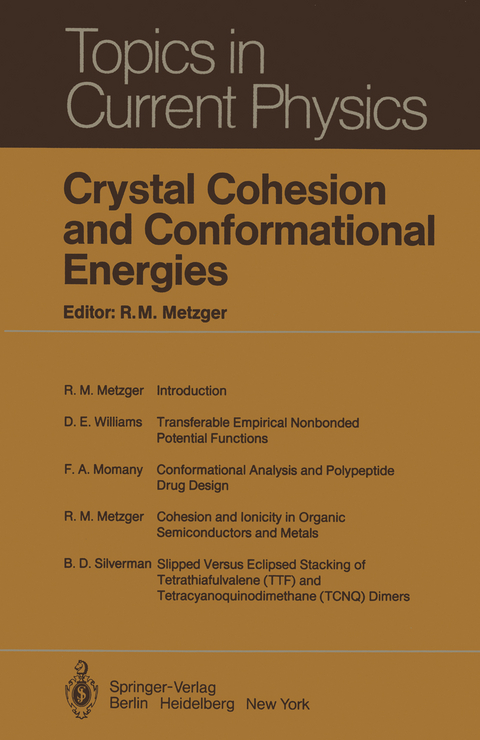
Crystal Cohesion and Conformational Energies
Springer Berlin (Verlag)
978-3-642-81579-9 (ISBN)
1. Introduction.- References.- 2. Transferable Empirical Nonbonded Potential Functions.- 2.1 Introductory Comments.- 2.2 Empirical Nonbonded Potential Models.- 2.3 Nonbonded Interactions in Molecular Crystals.- 2.4 Accelerated Convergence of Lattice Sums.- 2.5 Derivation of Nonbonded Potential Parameters.- 2.6 Extensions of the Potential Model.- 2.7 Appendix. Derivatives of C.- References.- 3. Conformational Analysis and Polypeptide Drug Design.- 3.1 Introductory Comments.- 3.2 Computational Procedures.- 3.3 Polypeptides and Their Constituents.- 3.4 Application of Conformational Information to Drug Design.- 3.5 Conclusions.- References.- 4. Cohesion and Ionicity in Organic Semiconductors and Metals.- 4.1 Introductory Comments.- 4.2 Crystal Cohesive Energies: General Theory.- 4.3 Born-Haber Cycles and Criteria for Ionicity.- 4.4 Lattice Energy Calculations.- References.- 5. Slipped Versus Eclipsed Stacking of Tetrathiafulvalene (TTF) and Tetracyanoquinodimethane (TCNQ) Dimers.- 5.1 Introductory Comments.- 5.2 Geometry of Donor-Acceptor ? Complexes: Slipped Versus Eclipsed Stacking.- 5.3 Molecular-Orbital Calculations.- 5.4 Interactions Between Closed-Shell Neutral TTF Molecules: Hard-Sphere Packing and Atom-Atom Potentials in Crystalline TTF.- 5.5 Density-Functional Calculation: Neutral TTF Dimer.- 5.6 Density-Functional Calculation: Open Shell TTF Dimer.- 5.7 Conclusions.- References.
| Erscheint lt. Verlag | 12.2.2012 |
|---|---|
| Reihe/Serie | Topics in Current Physics |
| Co-Autor | R.M. Metzger, F.A. Momany, B.D. Silverman, D.E. Williams |
| Zusatzinfo | XI, 154 p. |
| Verlagsort | Berlin |
| Sprache | englisch |
| Maße | 170 x 244 mm |
| Gewicht | 308 g |
| Themenwelt | Naturwissenschaften ► Physik / Astronomie ► Atom- / Kern- / Molekularphysik |
| Naturwissenschaften ► Physik / Astronomie ► Festkörperphysik | |
| Technik ► Maschinenbau | |
| Schlagworte | Chemistry • Cohesion • Crystal • crystal structure • Dispersion • Energies • Hydrogen • Kohäsion • Konformation • Konformation (Chem.) • Kristallstruktur • molecular solid • Molekülkristall • semiconductor |
| ISBN-10 | 3-642-81579-0 / 3642815790 |
| ISBN-13 | 978-3-642-81579-9 / 9783642815799 |
| Zustand | Neuware |
| Haben Sie eine Frage zum Produkt? |
aus dem Bereich


